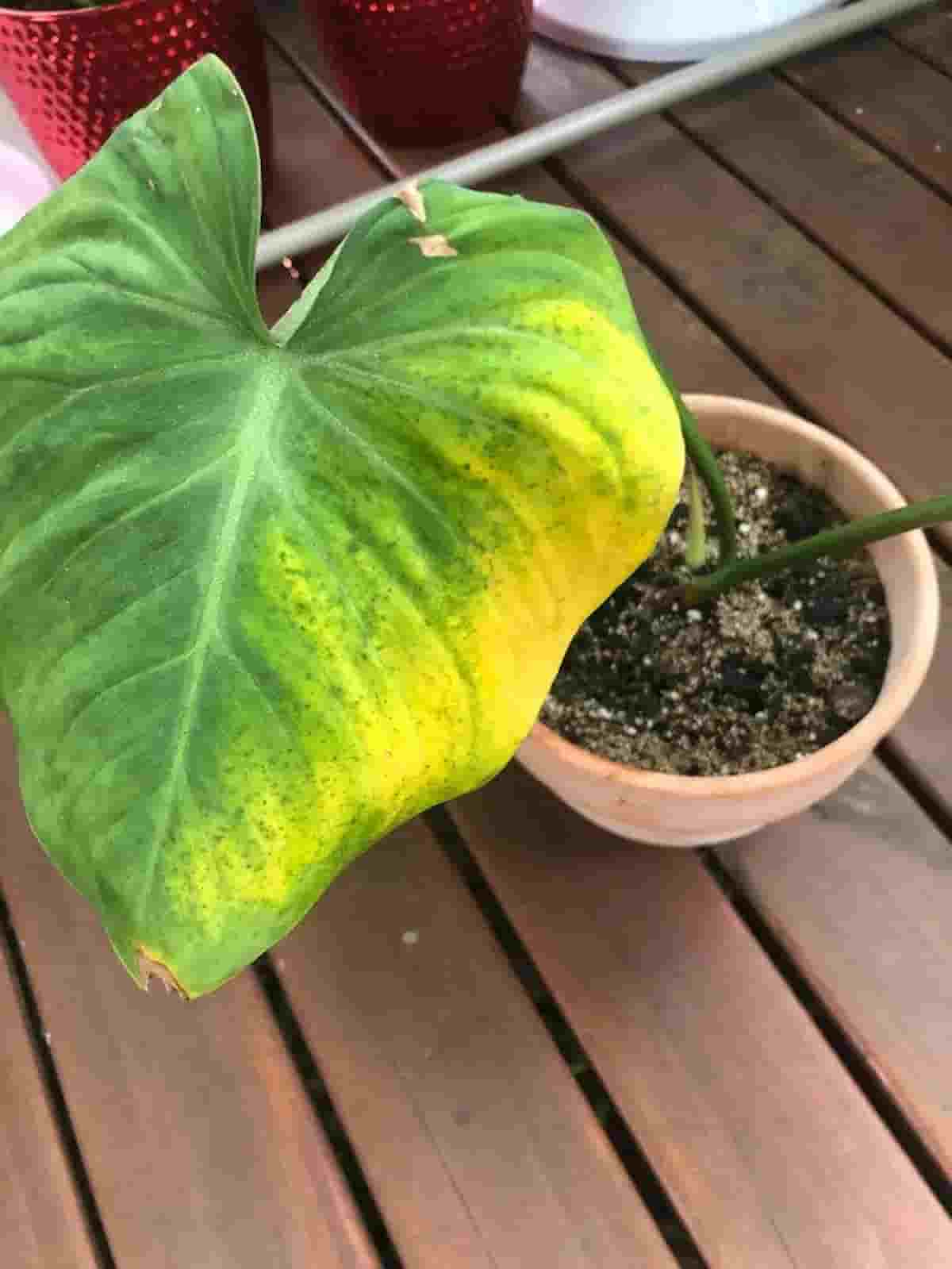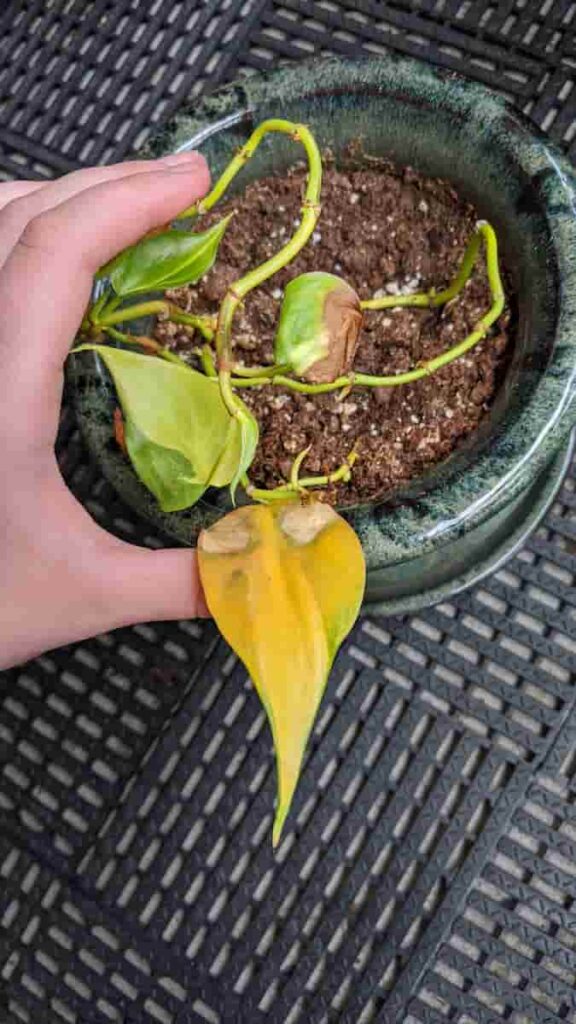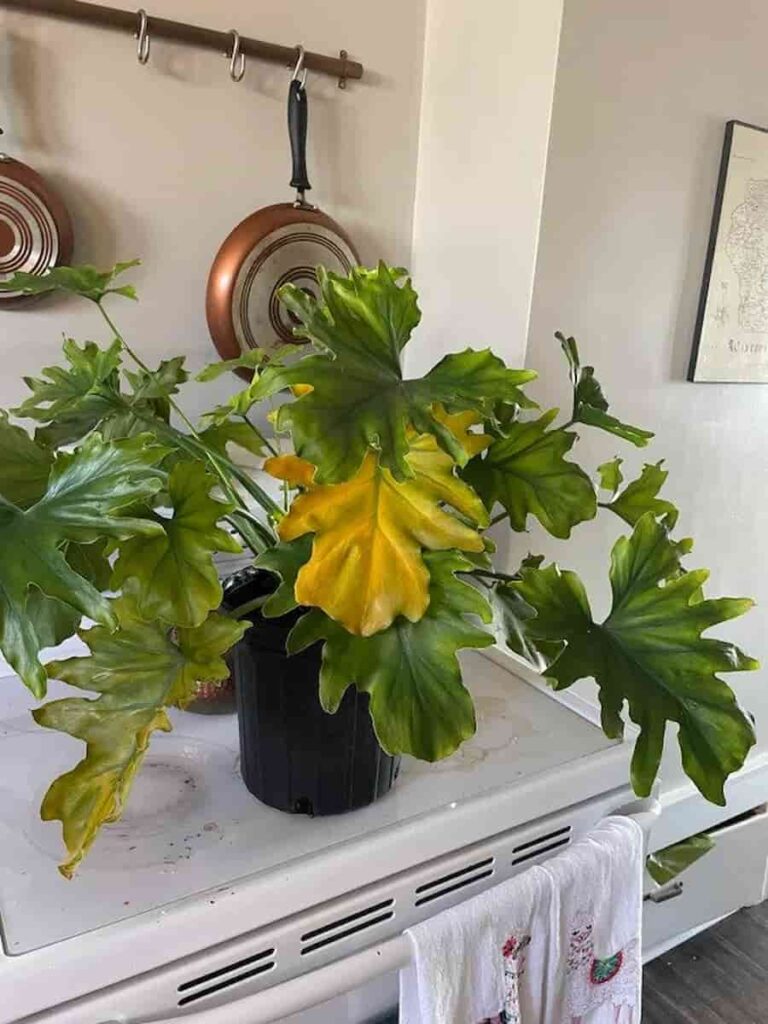Philodendrons have long been a houseplant favorite due to its striking foliage and no-fuss attitude.
Unlike some other tropical houseplants, philodendrons are fairly easy going and don’t require a lot of maintenance to care for. This makes them a great option for newbies.
Even though they are not a hard plant to grow, they can still experience their fair share of problems, and one of the most common issues is when your philodendron has yellow leaves.
Fortunately, most of the reasons behind philodendron leaves turning yellow aren’t too tricky to fix, as you’ll see below.

Table of Contents
Why are my philodendron leaves turning yellow?
The most common reason why your philodendron has yellow leaves is that it has incorrect levels of soil moisture. That said, there can be other causes, with some of the more frequent ones being low humidity levels, temperature stress, direct sun, pests, diseases, and even poor soil nutrition.
It generally becomes a process of elimination to find out what the reason in your case is, which is why working through the list below can be a real help.
1. Too much soil moisture
Too much moisture is a huge problem for houseplants like philodendrons, especially since it is so easy to overwater these plants. With that said, however, philodendrons do like their soil to stay moist, but too much moisture can cause the soil to stay soggy, which leads to root rot.
And root rot leads to death for the infected plant. Because of the seriousness of root rot for philodendrons, care must be taken not to overwater the plant. Additionally, overwater can also occur if the plant’s soil doesn’t allow for the excess water to drain out properly.

2. Too little soil moisture
While too much soil moisture is a bad thing, so is too little moisture. When you’re not watering the philodendron enough, you are causing the plant to dry out. Philodendron leaves turning yellow and falling off are two of the most common signs that the plant isn’t getting enough water.
While underwatering is not typically as much of a concern as overwatering, it can still harm your philodendron and turn its leaves yellow. Not giving the plant enough moisture can also stress the philodendron out and make it more susceptible to problems.
3. Humidity levels that are too low
Philodendrons need high levels of humidity, and not providing the plant with this can quickly start to take its toll. Not only do their leaves start to turn yellow, but they can also feel dried out and can even begin to droop and wilt.
Humidity levels that are at least 50 percent are required for philodendrons. With that said, however, they do their best when they have humidity levels a bit higher, closer to 70 percent.
4. Growing the philodendron at the wrong temperature
Tropical plants, such as philodendrons, must have temperatures that are constantly warm and mild. They are not cold hardy and cannot tolerate temps lower than 55 degrees for an extended period of time. Not ensuring the plant has its ideal temperature will cause damage to the plant’s leaves.
Furthermore, you should never try growing the philodendron outdoors unless you live in USDA hardiness zones 9 to 11. These are the only zones in which the philodendron is hardy to. Trying to plant the philodendron directly in the soil outside of these zones will quickly harm the plant.
5. Direct sunlight
Direct sunlight is too harsh for philodendrons, and can cause severe damage to its foliage. Yellowing leaves on your philodendron that are scorched and a reduced philodendron growth rate are just a few of the side effects that direct sunlight will cause to your plant.
If you’re not sure where you should position this plant based on your philodendron’s light requirements, consider sitting it next to an eastern-facing window that has a sheer curtain or blind. This will help to diffuse any sunlight coming in through the window and protect the philodendron from its harsh rays.

6. Too little light
Too little light is another reason why a philodendron has yellow leaves. Even though these plants can handle some shade, too much of it can have a negative effect on the overall health of the plant.
7. Pest infestation
Not only will a pest infestation cause yellow spots on philodendron leaves, but it can also make the plant more susceptible to more serious problems. Unfortunately, pests are a common problem for houseplants and they can quickly spread from one plant to another.
If you suspect your philodendron may have a pest infestation, guarantee the plant in a room without other houseplants and keep it there for at least 14 days after the pests have been taken care of. This will help to prevent pests from infesting your other plants.
8. Various plant diseases
Various diseases can also cause leaf discoloration on philodendrons. In fact, if the philodendron has yellow leaves with brown spots, it is probably caused by the disease known as Leaf Spot Disease.
This disease can be caused by both a fungal and bacterial pathogen, and is difficult to get rid of.
Related: 13 Reasons Why Your Philodendron Has Brown Spots (+ How to Fix It)
9. Normal occurrence due to old age
Sometimes, the yellowing leaves are simply due to old age. Older leaves of healthy philodendrons will start to yellow and then die off. The plant does this to make room for newer leaves.
If you notice the yellowing leaves are near the bottom of the plant and the philodendron isn’t showing any other signs that something is wrong, the yellowing leaves are more than likely a part of the plant’s normal life cycle.
10. Poor soil nutrition
Poor soil nutrition is another culprit of the philodendron leaves turning yellow.
Without the proper nutrients, philodendrons can start to develop nutrient deficiencies, and these deficiencies typically present themselves outwardly by discoloring the leaves.
11. Adding too much fertilizer
If your philodendron’s new leaves are turning yellow, the likely culprit is too much fertilizer. When you over fertilize a philodendron, you are causing a buildup of excess nutrients in the soil. This can lead to a slew of problems, including yellowing leaves, slowed growth, and overall poor health.

12. Improper care
As you can see, there is a running theme behind why a philodendron has yellow leaves and they can usually be traced back to improper care. That doesn’t mean, however, that all cases of yellow philodendron leaves are due to neglect, but it is a common theme.
How do you fix yellow leaves on a philodendron?
If your philodendron has yellow leaves due to under or overwatering, the best course of action is to adjust your watering schedule and, in the case of overwatering, repotting the philodendron to avoid root rot. For underwatering, a good drink should perk your plant up quickly.
Unfortunately, though, there is no simple answer to how to fix yellow leaves on a philodendron since the solution relies solely on what is causing the leaves to yellow in the first place. Once you have that information, you can take the necessary steps to correct the problem.
1. Give the philodendron the right amount of watering
Water is vital to ensure your philodendron is healthy and happy, and giving the correct amount of water goes a long way to preventing yellowing leaves.
However, the exact amount of water the plant needs varies on several factors. An easy way to check if the plant needs water is to test the soil dryness.
When the top two to three inches of soil start to feel dry, water the philodendron. A good general rule of thumb is to water about once every week. Even if you maintain this schedule, you should still check the soil moisture before watering the plant.
2. Keep the humidity levels near the philodendron high
Dry air, which occurs when the humidity level is too low, will quickly cause your philodendron’s leaves to yellow. By increasing the humidity level to at least 70%, you will prevent the philodendron leaves turning yellow.
Drip trays and humidifiers are easy ways to increase humidity levels. You can also mist the philodendron’s leaves with water to help up the humidity in the room.

3. Make sure the philodendron is kept in a warm climate
When the temperature drops below a certain degree, the philodendron will become stressed and it can begin to experience a wide array of symptoms, including yellowing leaves.
That is why it is important to keep the philodendron in an area where the temperatures are between 65 and 75 degrees.
4. Keep the philodendron out of direct sun
Even though philodendrons need bright light, they should never be placed in direct sunlight. Direct sunlight will cause the plant’s leaves to burn and turn yellow. Instead, aim to provide the philodendron with filtered or indirect sunlight.
Additionally, you should also never let the philodendron experience low levels of light. While it is true that philodendrons can tolerate some low light conditions, too much shade will cause stunted growth, poor health, and even yellow spots on philodendron leaves.
5. Regularly inspect the philodendron for pest problems
Sap-sucking insects, such as spider mites, mealybugs, aphids, and scales, can all cause yellow spots on philodendron leaves. While these pests are usually not considered a real threat, they can still put undue stress onto the plant.
The good news is that you can treat these pests by liberally applying insecticidal soap, horticultural oil, or neem oil. Additionally, the infested philodendron should be placed in a room away from other plants to help prevent the pests from spreading to your other houseplants.
6. Treat any fungal or bacterial diseases as soon as possible
Fungal and bacterial diseases are two unpleasant reasons why a philodendron has yellow leaves. Even with early treatment, these diseases can be difficult to get rid of and can even kill the plant. That is why preventive measures are always the best course of action.
To keep these diseases at bay, avoid overwatering the plant as this can lead to root rot. Additionally, when you water the philodendron, do so at the base of the plant and never from the top. When you water from the top, it can splash soil onto the plants’ leaves, and soil is where fungus and bacteria thrive.
7. Plant the philodendron in the right growing container
Just because a pot is a growing container doesn’t mean it is appropriate for philodendrons. The truth is, a lot of containers are just not the ideal option for houseplants that need soil that drains well.
Instead of simply repotting the philodendron in any old pot, select one that has the drainage holes at the very bottom and not along the sides.

8. Improve the organic matter of the philodendron’s soil
Nutrient deficiencies are a common problem with houseplants, and they can cause the philodendron’s leaves to turn yellow.
Thankfully, you can increase the organic matter in the plant’s soil to help keep the philodendron healthy and its leaves green. Using the best soil for philodendrons is ideal, but compost, worm castings, and mushroom compost are all good soil amendments that can help improve the soil’s nutrients.
9. Don’t over fertilize the philodendron
Over-fertilization can quickly turn a healthy philodendron into an unhealthy mess. To make matters worse, it is extremely easy to overfeed the plant, especially if you’re not sure what type of feed to use or how often.
One of the best ways to prevent over-fertilization is to use a liquid fertilizer and not a slow released version. Additionally, philodendrons do well with a balanced feed, such as 10-10-10, when applied once a month at 1/2 strength. All feeding should be stopped during the fall and winter when the plant isn’t actively growing.
Furthermore, always read and follow the application instructions on your bottle of fertilizer. Each brand and type of fertilizer is different and each has its own specific instructions tailored for that product. Not following the instructions could cause harm to you and your plant.
10. Make sure you are giving the philodendron everything it needs to survive
One of the best defenses against philodendron leaves turning yellow is to simply give the plant the things it needs to grow healthy and strong. This includes proper water, sunlight, humidity levels, temperature, feeding, growing medium, and even the right growing container.
Without these simple requirements, the philodendron will become susceptible to problems, such as leaf discoloration.
Should I remove yellow leaves from philodendron?
The yellow leaves should be removed from the philodendron and discarded (not composted.) Use a pair of sharp pruning shears and cut the leaves off near the leaf stem. However, even with the yellowed leaves removed, you still need to address the cause of the discoloration.
Just because you have removed the discolored leaves doesn’t mean the problem is fixed. If you don’t address the initial issue that resulted in the philodendron leaves turning yellow, then the foliage that is left will experience the same problem.
Once you’ve trimmed your philodendron so that the leaves have been removed, remember to clean and sanitize the pruning shears before putting them away. This will greatly reduce the spread of diseases.
Can yellow philodendron leaves turn green again?
Unfortunately, once your philodendron’s leaves are yellow, they usually cannot revert to their original green color. This is because the leaf has already lost its chlorophyll, which is what makes the plant’s foliage green, and once it is gone it cannot be restored.
Since the philodendron’s yellow leaves won’t turn green again, you can remove the discolored leaves to make room and energy for new leaves.
Just remember not to remove more than 75 percent of the plant’s total leaves, as this can cause even more negative effects on an already stressed and unhealthy philodendron.
You may also be interested in: 6 Easy Steps to Make Your Philodendron Fuller and Bushier
What causes yellow spots on philodendron leaves?
The most common cause of yellow spots on philodendron leaves is bacterial leaf spot disease. This disease is prevalent when there is poor air circulation, crowding, and high humidity levels. Additionally, water being allowed to sit on the plant’s leaves can also increase the chance of bacterial leaf spot.
The bad news is that there is no cure for bacterial leaf spot. You can try to control the disease by removing and discarding infected leaves and treating the plant with copper fungicide.
Another thing to consider is to separate the infected plant away from your other plants to help stop the spread of the leaf spot disease. Since there is no real cure or treatment for this disease, you shouldn’t take a chance on your other plant’s health and, instead, err on the side of caution.
Why are my philodendron’s new leaves turning yellow?
When a philodendron’s new leaves turn yellow, the likely cause is due to overwatering. Overwatering keeps the plant’s roots soggy, which prevents them from properly absorbing nutrients, which will cause all leaves, young and old, to start to discolor, wilt, droop, and fall off the plant.
Thankfully, overwatering is completely preventable, and can be kept away from the philodendron by ensuring the plant isn’t overly hydrated. Additionally, soggy roots can occur if the plant is growing in the wrong type of soil. For philodendrons, use a well-draining soil that isn’t compact.
Why does my philodendron have yellow leaves with brown spots?
When your philodendron has yellow leaves with brown spots, it’s a sure sign that the plant is too dry. This could be due to underwatering the plant, an environment that is too dry, not giving it enough humidity, or a combination of the three.
Keeping the plant’s soil moist but not soggy, misting the plant during periods of dryness, and increasing the humidity level to at least 70 percent can help prevent the leaves from turning yellow and dry.

Why are my philodendron leaves turning yellow and falling off?
One common reason why your philodendron leaves are turning yellow and falling off is that the leaves are simply old and the plant is getting rid of them to make room for new leaves. This is a natural part of the philodendron’s life cycle and nothing to be worried about.
On the other hand, the issue could be due to improper care, pests, and diseases. All of these problems can lead to the philodendron’s leaves turning yellow.
The best course of action is to ensure the plant has its ideal growing conditions and care requirements. It’s no secret that a healthy and well-cared for philodendron is much more likely to handle any problems that may come its way.
Why are my philodendron in water’s leaves turning yellow?
If your philodendron in water and its leaves are turning yellow it is being overwatered. Philodendrons are susceptible to overwatering, and overwatering is one of the worst things you can do to a houseplant as it can lead to root rot and, ultimately, the death of the plant.
Not only does overwatering interfere with the plant’s ability to properly absorb nutrients through its roots, but it leads to root rot. Root rot is an unpleasant plant disease that can quickly kill philodendrons, and there is no cure for it. Many gardeners that have experienced root rot have had to discard their plant in the trash because of this disease.
